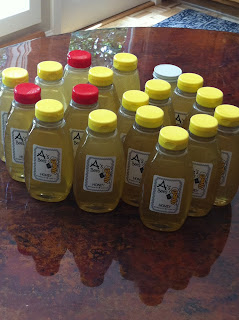 |
| Catalpa tree with colony of feral bees |
When my friend Susan heard about a swarm of bees in a tree in Upper Arlington, she called me to come with her to check it out. Swarming is something that happens when bees get crowded in their hives, primarily in the spring. The later in the season, the less likely the bees will be able to successfully relocate in a hive box and store enough honey to survive the winter. Since my last call about swarming bees a couple of weeks ago actually turned out to be nasty yellow jackets, and since it is way late in the summer for bees to swarm, we had no idea what we might actually find.
Nevertheless, Susan packed a ladder and her bee gear and I bought along all my protective clothing. In the surreal way life sometimes imitates art, as we rang the Upper Arlington doorbell I felt like we were a cross between the Keystone Cops, Ghostbusters and Winnie-the-Pooh. Trish, the homeowner, led us to her backyard. Even from the house, I could see bees zooming around about 12 feet up in a huge old catalpa tree.
Sure enough, just like my bees hang out on the front porch of my hives, there were hundreds of honeybees gathered around a silver dollar size hole in the trunk. Just chillin'. This was not a swarm, but a natural bee tree, a first for Susan and me. It is likely that these bees were a spring swarm and the scout bees found this terrific catalpa tree with a nice hole. A perfect home! The tree is probably hollow and is now filled with honeycomb, honey and brood. Trish had noticed the bees all summer and was not alarmed about them, but was willing for Susan to capture them and take them away.
 |
| See them now? |
I will ask about this in the beeyard tomorrow evening, but I believe the only way to capture these bees, including their queen, is to cut down the tree. As far as I know (which really isn't much), until the tree dies or splits, with some luck those bees will overwinter and just keep on beeing a feral colony. If they survive the winter, next spring it is possible the bees will make another queen and half the bees will swarm.
Trish, keep your eyes on those bees on warm days in the early spring. Who 'ya gonna call?
Meanwhile, back in my beeyard, this over anxious beekeeper didn't listen to the more experienced beekeeper who told me to keep the new queen cage taped closed for several days. I wanted the queen to be released before I left town last Thursday so I removed the tape and stuffed more fondant in the passage. When I opened the nuc last Wednesday, what was left of the queen was in the queen cage along with a dead worker. The honey in the frames had all been robbed out. There were dead bees on the bottom screen. Sadder but wiser (and poorer), I disassembled the nuc and put the frames with brood back into the other hives.
The other hives were buzzing. I had mixed up sugar water with Honey B Healthy, a delightfully fragrant mixture of essential oils that is good for bees, and had planned to start feeding the bees. The fall flowers are yet to bloom (especially goldenrod, a significant source of nectar) but if my nuc had been a going entity, those bees would have needed to be fed and if I feed one hive I need to feed them all to prevent ugly robbing behaviors. The frames in the three other hives had lots of honey, mostly uncapped. Without a refractometer (tool to determine the water content of the honey) I can't tell if uncapped honey is ready to harvest. Since the syrup was already made, even though the three colonies would probably have produced more honey for me to harvest, I officially ended the harvest season in Worthington by feeding my girls syrup and pollen patties. I will not harvest this adulterated honey.
Two of the 3 hives have deep boxes as their bases. I noticed that most of the frames were empty. I did find some stored bright yellow pollen and the smallest bit of brood in the deeps, but it is clear that the queens prefer the medium hive boxes. As the frames in the upper boxes fill with honey stores, the queens will be forced to return to the deeps to lay their eggs.
Because it has been so dry, the bees were hungry and not happy about me fooling with their colonies. There was lots of zooming about and I used plenty of calming smoke. Still, one of the girls gave up her life to protect her hive and I got the slightest bit of a sting through my glove on the top of my right index finger. Her heart wasn't in it (nor was her stinger) so the tiny red spot was gone in 24 hours.
STING COUNT:
2012 5
2011 13










